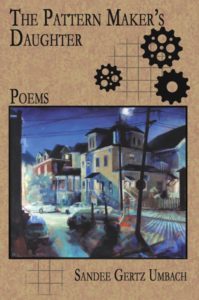Poetry collections by Sandee Gertz Umbach and Lori Lamothe evoke a broad array of reactions, responses, feelings, and understandings, but perhaps most of all they prompt consideration of what inspires a poem, and what inspires an entire collection. It’s easy enough to say “whatever moves me, ” but the fact is that poetic inspiration comes from what we experience, what we see, what we feel, where we come from, what we believe, and how we think.
For poet Sandee Gertz Umbach, the inspiration for the 49 poems of The Pattern Maker’s Daughter is childhood and the specific geography in which she spent her childhood—Johnstown, Pennsylvania. Most of us associate Johnstown with steelmaking and the great floods of 1889, 1936, and 1977 (those were the major floods: there were also many minor ones). “Pattern maker” is, in fact, a specific job in the steel industry, one held by Umbach’s father (her grandfather also worked in the steel industry).
This is a thematic collection. All of the poems are about growing up in Johnstown, the floods that afflicted the community, the industry that thrived there, and the landscape that hosted all of these things. This is one of the poems of childhood memory.
Last Light

were clanging their evening music,
mother made lists in whispers:
upstairs floorboards this week;
next week, the shelves …
Outside, the earth was speaking,
children ducking under clotheslines,
neighbors checking the reds of tomatoes,
while women retrieved the last of the day’s wash,
rolling up the rope in tight weary circles.
On beds of weeds, I sat in the alley;
listened to Mrs. Geisel’s splashing faucets,
Minnie Miller swigging Maalox in the next kitchen,
a chorus of housedresses shifting,
Brillo sliding across the stainless.

Sandee Gertz Umbach
Umbach was born and raised in the Johnstown area. She received a Master of Arts in Creative Writing degree and her Master of Fine Arts degree from Wilkes University. In 2000, she was awarded a poetry fellowship from the Pennsylvania Council on the Arts. Umbach lives in Nashville.
The Pattern Maker’s Daughter is a beautiful collection about family and community, and how fragile they can be.
For poet Lori Lamothe, the inspiration is clearly science.
In the 81 poems of Trace Elements by Lori Lamothe, we discover a multiplicity of inspirational sources—history, music, daily life, the seasons, relationships, but especially science. The collections include poems with titles like “Geode, ” “Dark Matter, ” “The Physicist at the Clinic, ” “Horseshoe Crabs Are Living Fossils, ” “Hypothesis #C, ” and even “Museum of Natural History.”
The language, images, and words of Trace Elements are vivid and precise. Lamothe covers a wide range of topics, but each of the poems shares this vividness and precision (perhaps the voice of a scientist?). This is seen even in the “non-science” poems in the collection.
Open & Closed Spaces

like a kid escaping from school.
My mood trails behind,
makes meticulous tracks on winter’s paper.
Up ahead, trees translate wind into audible
landscape, a calligraphy of shadows.
Then the lake opens its watercolor eye,
its blue gaze so wide
I could touch a fingertip to ice
and feel the sea.
To shut the door on open space is to trade distance
for fire. The unknown for a dog curled around sleep.
Risk for lamps shining safety.
So easy that way
to keep life at an optimal temperature.
For no good reason, I leave the scene ajar,
the pause after the final image an unread fortune,
a rover of air between worlds,
a draft any change might cross.

Lori Lamothe
Trace Elements is filled with poems like that, the blending of observation, questioning, experimentation, and synthesis.
Lamothe has also published the collection Happily and three chapbooks, Camera Obscura, Diary in Irregular Ink, and Ouija in Suburbia (Trace Elements incorporates some of these chapbook poems). Her poems have been published in such literary journals as Alaska Quarterly Review, Blackbird, CALYX, Notre Dame Review, Seattle Review, and others. She lives in New England.
Both the Umbach and Lamothe collections demonstrate the many and varied sources of poetic inspiration, and how poets shape their words and images to communicate what inspires them.
Photo by Holley and Chris Melton, Creative Commons, via Flickr. Post by Glynn Young, author of the novels Dancing Priest and A Light Shining, and Poetry at Work.
__________________________

“I require all our incoming poetry students—in the MFA I direct—to buy and read this book.”
—Jeanetta Calhoun Mish
- Poets and Poems: Avraham Stern and “A Soldier and a Poet” - July 15, 2025
- Poets and Poems: Beth Copeland and “I Ask the Mountain to Heal My Heart” - July 10, 2025
- A.E. Stallings: the Parthenon Marbles, Poets, and Artists - July 8, 2025

Maureen says
Good post, Glynn.
Some wonderful imagery in both selections; Umbach’s is particularly effective, because of the action the images create (they’re propulsive).
I love this line: “Minnie Miller swigging Maalox in the next kitchen”. A poet after my own heart.
Laura Lynn Brown says
“Last Light” takes me back to similar evenings on Kennon Street. I love “a chorus of housedresses.”
Lori Lamothe: I like the way she sees: “the lake opens its watercolor eye,” “a dog curled around sleep.”
Bethany says
Thank you for sharing your take on these collections and poets.
What gorgeous lines by Lori Lamothe:
“Up ahead, trees translate wind into audible
landscape, a calligraphy of shadows.
Then the lake opens its watercolor eye,
its blue gaze so wide”
And Umbach’s style and voice in the “Last Light” poem resonates with me. I would like to read more of her poetry.